You'll find Earth's most captivating destinations far beyond the beaten path, where ancient traditions still thrive and untouched landscapes await. Trek to Bhutan's remote mountain villages to witness yak-hair weaving, or explore Madagascar's hidden beaches along its pristine coastline. Discover Romania's painted monasteries with their vibrant frescoes, and wander through Sudan's forgotten pyramids at Meroe. In Uzbekistan's ancient markets, you can bargain for spices and textiles, while Mongolia's sacred lakes offer spiritual ceremonies led by shamans. These extraordinary places hold countless stories and experiences that'll transform your understanding of our world.
Key Takeaways
- Remote mountain villages in Bhutan offer authentic cultural experiences with traditional practices, unique dialects, and seasonal festivals.
- Madagascar's hidden beaches along its 3,000-mile coastline provide pristine, secluded spots away from typical tourist destinations.
- Romania's painted monasteries showcase remarkable medieval frescoes and religious artistry recognized as UNESCO World Heritage sites.
- Ancient markets in Uzbekistan preserve traditional trading customs while offering vibrant displays of spices, carpets, and cultural exchange.
- Mongolia's sacred lakes combine spiritual significance with nomadic lifestyle experiences, featuring traditional ceremonies and local customs.
Hidden Mountain Villages of Bhutan
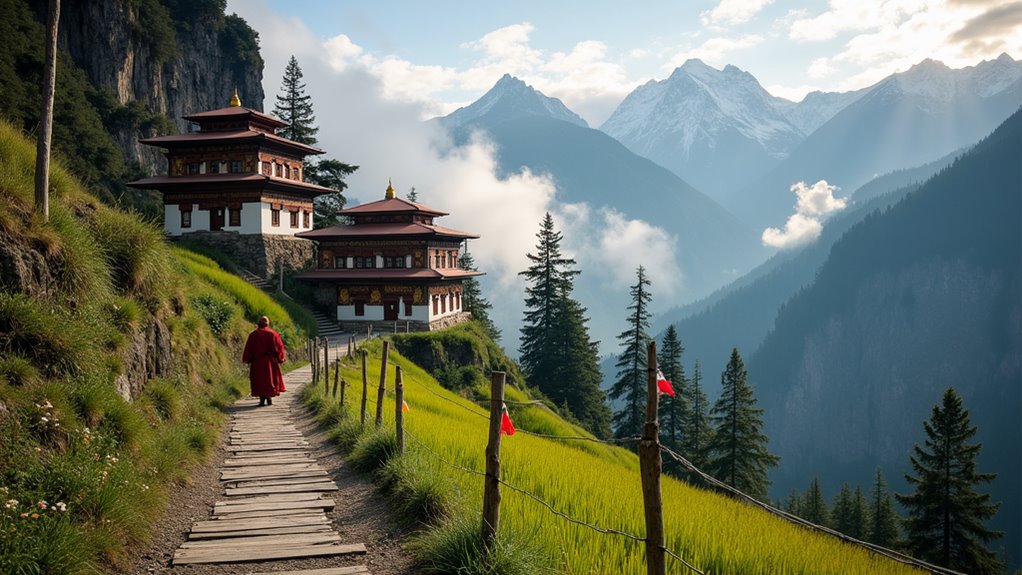
While most travelers flock to Bhutan's popular dzongs and monasteries, the country's remote mountain villages offer an intimate glimpse into authentic Himalayan life.
You'll discover villages like Laya, perched at 12,000 feet, where indigenous Layap people maintain centuries-old traditions and wear distinctive conical bamboo hats.
In these settlements, you can witness daily routines unchanged by time – from butter tea preparation to traditional weaving of yak hair textiles.
Each village has its own dialect, customs, and seasonal festivals that you won't find in guidebooks.
The challenging trek to reach these communities adds to their mystique, requiring guidance from local porters who know hidden trails through rhododendron forests and across high-altitude passes.
You'll need permits and a licensed tour operator to access these protected areas.
Romania's Painted Monasteries
Hidden in Romania's northeastern region of Bucovina, the painted monasteries stand as masterpieces of Byzantine art and medieval architecture.
These UNESCO World Heritage sites feature vibrant frescoes adorning both interior and exterior walls, depicting biblical scenes and the lives of Orthodox saints.
You'll find the most spectacular examples at Voroneț, known for its distinctive blue pigment, and Sucevița, where green dominates the detailed murals.
The 15th and 16th-century paintings have survived centuries of weathering, thanks to unique mineral pigments and expert craftsmanship.
As you explore these sacred spaces, you'll notice how the frescoes served as "picture Bibles" for illiterate worshippers, telling stories through intricate illustrations.
Each monastery offers a different artistic perspective, with Humor and Moldovița completing the main circuit of must-see sites.
Lost Cities of Sudan
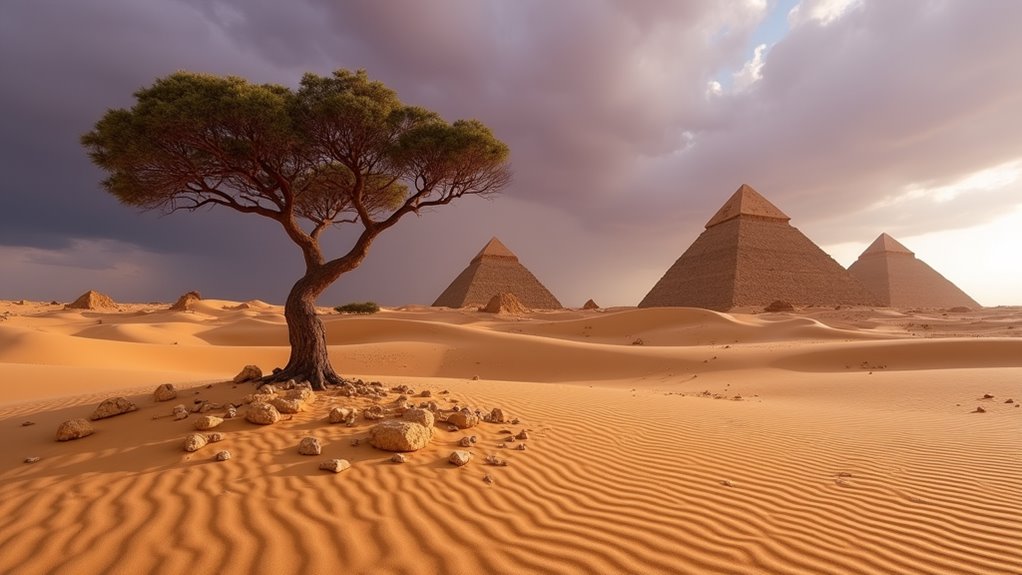
Moving from Romania's religious artistry to Africa's ancient wonders, Sudan's archaeological treasures remain largely unexplored by mainstream tourists.
You'll find ancient pyramids at Meroe, where over 200 steep-sided structures pierce the desert skyline, rivaling Egypt's famous monuments without the crowds.
In the ancient city of Napata, you can explore the ruins of the once-mighty Kushite kingdom, including the sacred mountain of Jebel Barkal.
The lost city of Naqa showcases impressive temples dedicated to the lion-headed god Apedemak, while nearby Musawwarat es-Sufra features the mysterious Great Enclosure, a massive complex of courtyards and passages whose purpose still puzzles archaeologists.
These sites offer you a rare glimpse into the powerful civilizations that once ruled the Nile Valley, far from the well-worn tourist paths.
Secret Beaches of Madagascar
Several pristine beaches dot Madagascar's 3,000-mile coastline, far from the tourist-heavy shores of neighboring island nations.
You'll find the secluded Salary Beach tucked away in the southwest, where turquoise waters meet powdery white sand without a resort in sight.
Head to the remote Anjajavy Peninsula to discover hidden coves accessible only by boat, where red tsingy formations create dramatic backdrops against crystalline waters.
For the ultimate escape, make your way to Ankobahoba Beach on Nosy Be island, where you can swim in complete solitude among coral reefs.
The nearby fishing village of Andilana offers glimpses into local life, while mangrove forests shelter rare Madagascar fish eagles.
Time your visit between April and November to avoid cyclone season and experience these secrets at their best.
Ancient Markets of Uzbekistan
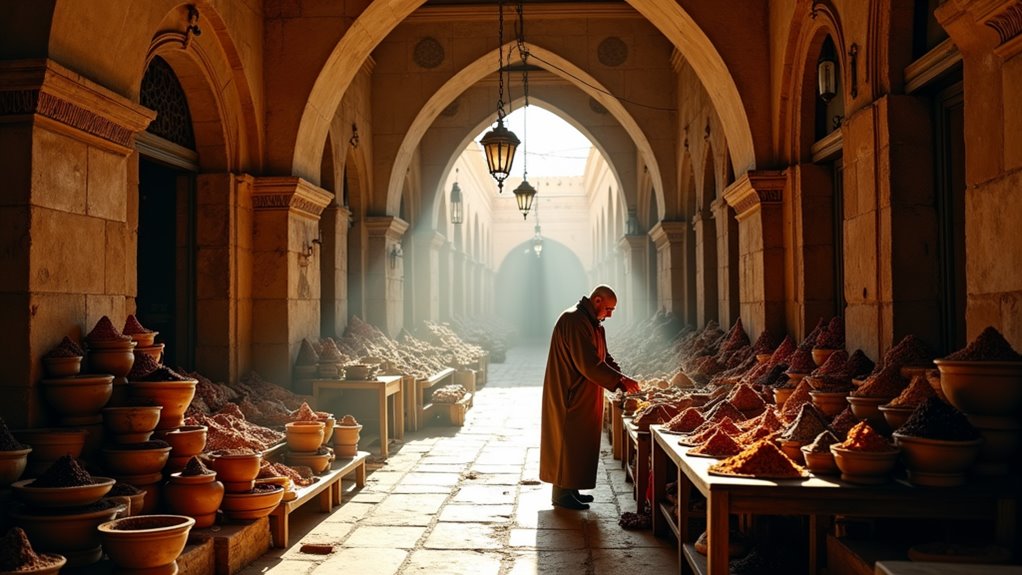
You'll find yourself transported back in time as you walk through Uzbekistan's ancient markets, where millennia-old spice routes once connected Asia to Europe.
The bustling bazaars of Tashkent, Samarkand, and Bukhara still maintain their centuries-old trading traditions, with merchants selling everything from hand-woven carpets to aromatic spices in the same spots their ancestors once stood.
These historic marketplaces showcase stunning Islamic architecture with their iconic turquoise domes, intricate tile work, and towering archways that have witnessed countless commercial transactions since the days of the Silk Road.
Spice Routes and Bazaars
Along the legendary Silk Road, Uzbekistan's ancient bazaars still pulse with the same vibrant energy that drew merchants centuries ago.
You'll discover a mesmerizing array of spices, from fragrant saffron to pungent cumin, displayed in towering pyramids at markets like Tashkent's Chorsu Bazaar.
As you wander through the labyrinthine alleys, you'll find yourself immersed in centuries-old trading traditions. Local merchants beckon you to sample their wares, from dried fruits and nuts to handwoven textiles.
The historic Silk Road cities of Bukhara and Samarkand offer trading domes where you can bargain for traditional crafts and textiles. Don't miss the spice masters who'll help you distinguish between varieties of peppercorns and show you how to select the freshest cardamom pods.
Trading Traditions Still Alive
The ancient trading customs of Uzbekistan endure through generations of dedicated merchants who've preserved their ancestors' techniques.
You'll find these traditions alive in bustling markets like Tashkent's Chorsu Bazaar, where traders still practice the art of bargaining passed down since the Silk Road era.
As you wander through the domed marketplace, you'll notice merchants displaying their wares exactly as their forebears did – with spices heaped in vibrant mounds, handwoven textiles draped artfully, and traditional ceramics arranged with precision.
The vendors maintain age-old practices, from the careful weighing of saffron to the intricate folding of silk scarves.
They'll invite you to share tea while discussing their crafts, a ritual that's remained unchanged since caravans first crossed these storied trading routes.
Architecture of Ancient Commerce
While modern shopping centers dot Uzbekistan's cities today, ancient market architecture still dominates the commercial landscape through magnificent trading domes and restored caravanserais.
You'll find these architectural marvels in cities like Bukhara and Samarkand, where centuries-old bazaars continue to thrive beneath intricately designed cupolas.
The trading domes, known locally as taki, feature distinctive ribbed vaulting and precise geometric patterns that helped regulate temperature in the intense desert climate.
You'll notice how the builders positioned windows strategically to illuminate merchant stalls while keeping the heat at bay.
In the caravanserais, former merchant lodgings showcase sturdy arched entrances, spacious courtyards, and two-story galleries where traders once stored their valuable silk and spice cargo.
Forgotten Castles of Slovenia
Hidden within Slovenia's lush forests and perched atop dramatic cliffs, dozens of medieval castles remain largely unexplored by mainstream tourists.
You'll find weathered fortresses like Celje Castle, where crumbling walls tell tales of the powerful Counts of Celje, and Predjama Castle, built daringly into a cave mouth. These forgotten strongholds offer glimpses into Slovenia's feudal past.
While Bled Castle draws crowds, you can venture to lesser-known gems like Žužemberk, a 13th-century fortress overlooking the Krka River, or Kostel Castle, which guards the Croatian border.
Many of these sites feature preserved dungeons, chapels, and defense towers. You'll often have these atmospheric ruins to yourself, free to explore their stone corridors and imagine life within their ancient walls.
Sacred Lakes of Mongolia
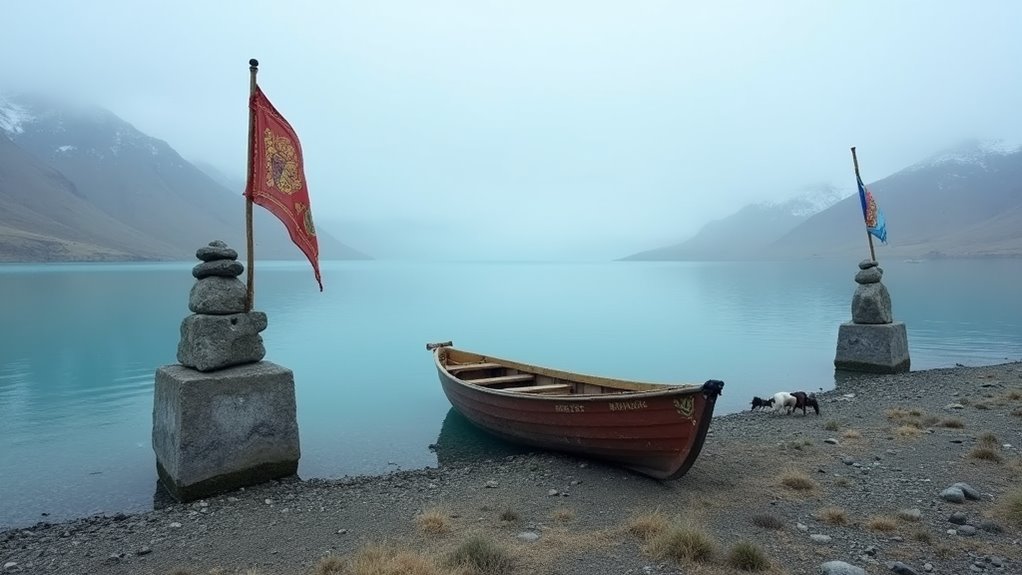
You'll find Mongolia's sacred lakes steeped in centuries-old traditions, where locals still place offerings of milk and coins at the water's edge.
Throughout the year, shamans lead ceremonies invoking the spirits believed to dwell within these pristine waters.
If you're lucky, you'll catch glimpses of nomadic families setting up their gers near the shoreline, maintaining their ancestral connection to these revered bodies of water.
Ancient Rituals and Offerings
Deep within Mongolia's untamed wilderness, sacred lakes have served as spiritual epicenters for ancient shamanic rituals and offerings for thousands of years.
You'll witness locals performing "milk sprinkling" ceremonies, where they cast droplets of fresh milk onto the crystalline waters to honor water spirits and ensure good fortune.
As you explore these revered sites, you'll notice colorful prayer flags and stone cairns called ovoos surrounding the shorelines.
These sacred markers represent the bridge between the physical and spiritual realms. Local shamans still conduct traditional ceremonies here, burning juniper branches and offering blue silk scarves called khadags to the water deities.
Don't be surprised if you're invited to participate in a ritual – it's considered an honor to join in these ancient practices that connect past to present.
Nomadic Life by Water
Living alongside Mongolia's sacred lakes, nomadic families maintain traditions that stretch back centuries.
You'll find their gers (traditional yurts) dotting the shores of Lake Khövsgöl and Lake Terkhiin Tsagaan, where they move seasonally with their livestock.
These families haven't just adapted to lake life – they've made it central to their existence. You'll see them collecting pure water from natural springs, fishing for lenok trout, and treating the lakes with deep reverence.
During your stay, you can help herd sheep across shallow waters, learn to milk mares on the lakeshore, or join in the preparation of traditional dairy products like aaruul.
The lakes aren't just water sources; they're sacred spaces where nomads honor water spirits through quiet rituals and daily practices.
Frequently Asked Questions
What Is the Best Time of Year to Visit These Remote Destinations?
You'll find the best timing varies significantly for remote destinations. Plan your visit during shoulder seasons (spring or fall) when you'll encounter fewer tourists and more moderate weather.
If you're heading to polar regions, target their summer months (December-February for Antarctica, June-August for the Arctic).
For desert locations, choose winter months to avoid extreme heat and dangerous conditions.
How Safe Is It to Travel Alone to These Lesser-Known Locations?
While traveling alone to lesser-known destinations can be rewarding, you'll need to take extra precautions.
Research your destination thoroughly, share your itinerary with family, and stay connected with a working phone. You'll want to book accommodations in advance, avoid walking alone at night, and trust your instincts.
Consider joining local tour groups or finding travel companions through reputable platforms for added safety.
Are There English-Speaking Guides Available in These Remote Places?
You'll find English-speaking guides in most remote destinations, though availability varies.
It's best to book through established tour companies or local tourism offices that specialize in English tours.
If you're heading somewhere particularly remote, you might need to arrange a guide in advance.
Some locations may only have guides who speak basic English, so it's helpful to learn a few local phrases too.
What Vaccinations and Medical Preparations Are Required for Visiting These Destinations?
You'll need several essential vaccinations before visiting remote destinations.
Make sure you're up-to-date on routine shots like MMR and DPT. You should also get hepatitis A and B, typhoid, and possibly yellow fever vaccines depending on your specific destination.
Don't forget to pack antimalarial medication, antibiotics, and a basic medical kit.
Consult your doctor at least 6-8 weeks before travel for proper guidance.
How Reliable Is Internet Connectivity and Cell Service in These Areas?
Far and away, you'll find connectivity varies dramatically in remote destinations.
You can expect sporadic to nonexistent cell service and limited internet access in most off-the-beaten-path locations. It's best to prepare for digital detox by downloading offline maps, important documents, and entertainment before your trip.
Some areas might offer basic Wi-Fi at lodges or community centers, but don't count on reliable speeds or constant availability.
Conclusion
You'll discover that these seven extraordinary destinations share an uncanny connection – they're all places where ancient trade routes once intersected. By pure chance, each location still bears traces of those historic crossroads today. Whether you're meditating in a Bhutanese monastery or haggling in an Uzbek bazaar, you're walking the same paths as countless travelers before you, keeping their stories alive.
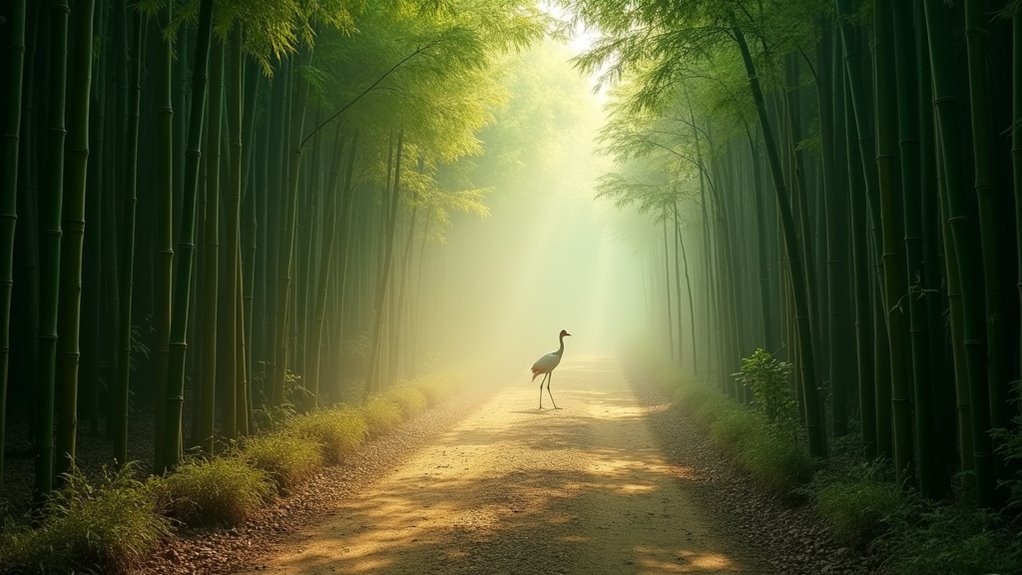
Leave a Reply